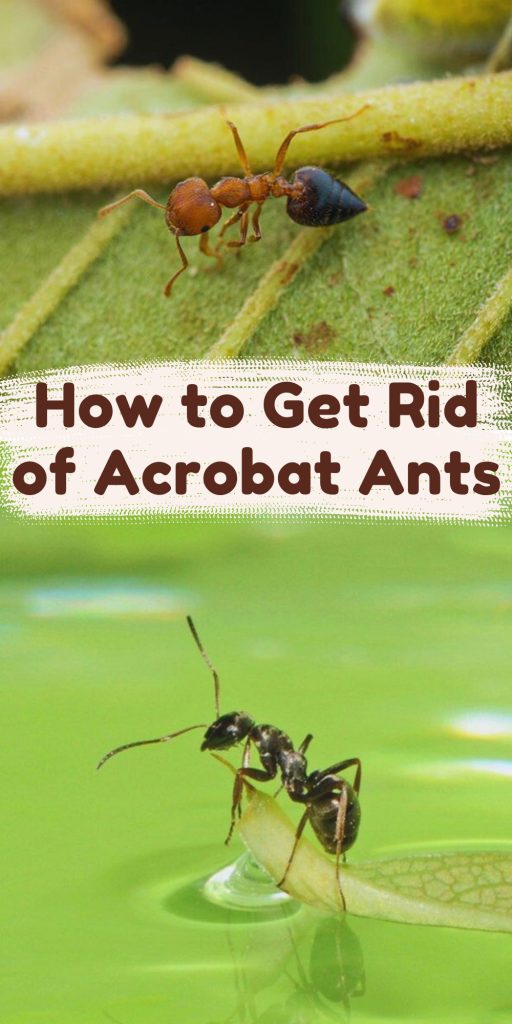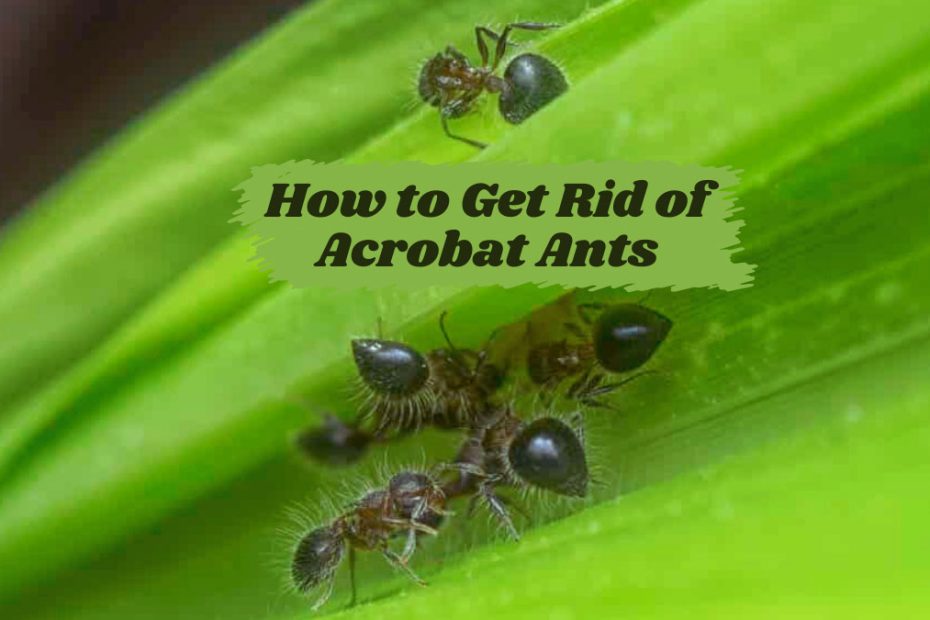Finding acrobat ants in your home can be frustrating. These tiny pests, known for their unique ability to raise their abdomen over their head, can quickly become a nuisance. They often invade homes searching for food and shelter, and if left unchecked, they can cause structural damage by nesting in wood and insulation.
Key Takeaways
- Identification and Behavior: Acrobat ants are small, usually light brown to black, and can be recognized by their distinct heart-shaped abdomen and the behavior of raising their abdomen over their head when threatened.
- Preferred Habitats: These ants thrive in moist environments and often nest in wood, insulation, or soil. They can move into homes from outdoor areas.
- Diet: Acrobat ants are omnivorous, eating smaller insects, sugary substances like honeydew, and protein sources such as meat and greasy foods.
- Prevention Tactics: Key prevention strategies include sealing entry points, addressing moisture issues, maintaining clean food storage, and regular inspections of wooden structures and moist areas.
- Extermination Methods: A combination of chemical and natural solutions is effective; using insecticides, bait stations, and natural repellents like essential oils and diatomaceous earth.
- Long-Term Solutions: Engage professional pest control services for persistent infestations and commit to regular follow-up measures, such as inspections and maintaining barriers, to prevent reinfestation.

Understanding Acrobat Ants
Acrobat ants are a fascinating but bothersome pest. They carry the scientific name Crematogaster, and you can recognize them by their distinct behavior and appearance.
Key Characteristics
- Behavior: Known for raising their abdomen over their head when threatened.
- Appearance: Small in size, usually light brown to black. The heart-shaped abdomen is a distinguishing feature.
- Nesting Habits: Often nest in wood, insulation, or soil. Acrobat ants may also establish colonies inside homes.
Habitat Preferences
Acrobat ants thrive in moist environments. If they identify an entry point, they’ll move from outdoor areas like trees and firewood stacks into your home in search of food and shelter.
Diet and Foraging
Acrobat ants are omnivorous, meaning they eat a variety of food sources. These include:
- Insects: They prey on smaller insects or scavenge their remains.
- Sweet Substances: They are drawn to sugary foods like honeydew from aphids.
- Proteins: You’ll often see them foraging for proteins found in meat or greasy foods.
Potential Issues
Ignoring an acrobat ant infestation can lead to:
- Structural Damage: They can nest in wood, compromising its integrity.
- Electrical Problems: Acrobat ants may chew through insulation, posing a risk of short circuits.
- Food Contamination: They may contaminate food supplies, risking health issues.
Identification Tips
To identify an acrobat ant infestation:
- Spot the Ants: Look for small ants with a distinctive heart-shaped abdomen.
- Search for Trails: Follow their foraging trails, usually leading to food sources.
- Inspect Wood: Check wooden structures like decks or beams for signs of nesting.
- Stay vigilant by regularly inspecting potential nesting sites.
- Address moisture issues to make your home less appealing to these pests.
- Maintain clean food storage to prevent attracting acrobat ants.
Understanding acrobat ants helps you better manage and prevent infestations, ensuring a pest-free home.
Identifying Infestation
Identifying an acrobat ant infestation early helps mitigate potential damage. Recognize common signs to pinpoint an infestation effectively.
Common Signs
Look for these indicators to confirm the presence of acrobat ants:
Heart-Shaped Abdomen: Acrobat ants have a distinctive heart-shaped abdomen. Spotting this feature can help identify them.
Foraging Trails: These ants form noticeable trails when foraging. Follow these trails to locate nests.
Dead Insects: Acrobat ants, being omnivores, leave behind dead insects. Find these remnants around entry points.
Wood Damage: Inspect wooden structures for damage or sawdust indicating nesting activity.
Areas to Inspect
Check these specific areas for signs of infestation:
Wooden Structures: Examine wooden beams, floors, and walls. Look for sawdust or small entry holes.
Insulation: Inspect insulation in walls and attic spaces, where ants might nest and cause property damage.
Moist Areas: Acrobat ants thrive in moist environments. Check basements, bathrooms, and kitchens for nests or trails.
Outdoor Entry Points: Look around windows, doors, and foundation cracks. These can be access points for ants entering your home.
Regular inspections of these areas can help you identify an infestation early, allowing for prompt and effective treatment.
Prevention Methods
To prevent acrobat ants, a combination of home maintenance and landscaping steps is necessary. Addressing potential entry points and nesting areas can significantly reduce the risk of an infestation.
Home Maintenance Tips
Effective home maintenance can deter acrobat ants. Focus on these areas:
- Sealing Entry Points: Use caulk or weather stripping to seal cracks and gaps in windows, doors, walls, and foundations. Ants often enter through tiny openings.
- Addressing Moisture Issues: Repair leaky pipes and faucets. Use dehumidifiers in damp areas like basements and crawl spaces.
- Food Storage: Keep food in airtight containers. Clean up spills promptly and remove trash regularly.
- Regular Inspections: Check wooden structures, insulation, and moist areas for signs of ants. Early detection can prevent large infestations.
Landscaping Considerations
Your yard’s layout can influence ant infestations. Consider these landscaping tips:
- Trim Plants and Trees: Keep branches and shrubs trimmed away from the house to limit ants’ access points.
- Remove Debris: Clear yard debris like fallen leaves, wood piles, and mulch. These can provide nesting sites for ants.
- Control Moisture Outdoors: Ensure proper drainage around the homeâs foundation. Avoid overwatering plants.
- Barrier Treatments: Apply insecticide treatments around the exterior foundation and entry points. These create an additional barrier to prevent ants from entering.
Maintaining a well-groomed yard and addressing key home maintenance issues can significantly reduce the risk of acrobat ant infestations. Regular vigilance and prompt action are crucial.
Extermination Techniques
Exterminating acrobat ants requires a mix of chemical and natural solutions. Both methods offer their own advantages and can be tailored to your specific situation.
Chemical Solutions
Chemical insecticides can effectively eliminate acrobat ants. Consider the following options:
Insecticidal Sprays:
Use insecticidal sprays labeled for ants. Apply directly to nests, trails, and entry points. These sprays often contain pyrethroids, which target the ant’s nervous system.
Bait Stations:
Set up ant bait stations near trails and nests. Baits containing hydramethylnon, fipronil, or boric acid attract ants, which carry the poison back to their colony, ensuring widespread extermination.
Residual Insecticides:
Apply residual insecticides around entry points and potential nesting sites. Ingredients like deltamethrin create a long-lasting barrier that kills ants upon contact.
Natural Remedies
Natural remedies provide eco-friendly alternatives. Here’s how you can use them:
Diatomaceous Earth:
Sprinkle food-grade diatomaceous earth around entry points and nesting areas. This powder dehydrates and kills ants without using chemicals.
Essential Oils:
Mix essential oils like peppermint, tea tree, and citrus with water. Spray the mixture on ant trails and around entry points. The strong scents repel ants.
Vinegar Solution:
Combine equal parts vinegar and water in a spray bottle. Use this solution to clean surfaces and disrupt ant trails. Vinegar masks the pheromones ants use for navigation.
Incorporating these techniques provides a comprehensive approach to exterminating acrobat ants. By combining chemical and natural methods, you ensure a more effective and environmentally conscious strategy.
Long-Term Solutions
Long-term solutions are essential to keep acrobat ants away from your home. Consider both professional pest control services and follow-up measures to ensure lasting results.
Professional Pest Control
Professional pest control provides expertise and thorough treatment. Hiring a licensed pest control company often proves more effective than DIY methods for persistent infestations.
Key services include:
- Inspection: Professionals rigorously inspect your home to identify ant colonies, nesting sites, and potential entry points.
- Treatment: They apply specialized treatments, from insecticidal sprays to baiting systems designed to eradicate acrobat ants.
- Follow-Up: Many companies offer follow-up visits to ensure the problem is completely resolved and to monitor for any signs of reinfestation.
Follow-Up Measures
Consistent follow-up measures are necessary to prevent future infestations and protect your home.
- Regular Inspections: Conduct regular inspections to detect any signs of ant activity early.
- Maintain Barriers: Reapply barrier treatments around the foundation and entry points to keep ants from entering.
- Fix Moisture Issues: Address moisture problems by repairing leaks and using dehumidifiers in damp areas.
- Cleanliness: Store food in airtight containers, keep surfaces clean, and clear away crumbs and spills promptly.
Committing to professional pest control and diligent follow-up measures significantly reduces the risk of acrobat ant reinfestation, ensuring your home stays protected.
Conclusion
Successfully managing an acrobat ant infestation requires a proactive approach. Regular inspections, both indoors and outdoors, help catch early signs of these pests. By addressing moisture issues and sealing entry points, you can create an environment that’s less inviting to acrobat ants.
Employing a combination of chemical and natural extermination methods ensures thorough treatment. For long-term peace of mind, consider enlisting professional pest control services. Their expertise and follow-up visits can provide a comprehensive solution, keeping your home free from acrobat ants and the damage they cause.
Frequently Asked Questions
What are acrobat ants?
Acrobat ants, scientifically known as Crematogaster, are small ants with a distinctive heart-shaped abdomen. They raise their abdomen over their head when disturbed and nest in wood, insulation, or soil.
How do acrobat ants enter homes?
Acrobat ants can enter homes from outdoor areas through cracks, gaps around windows and doors, and other entry points. They are attracted to moist environments and can easily invade in search of food and shelter.
What damage can acrobat ants cause?
Acrobat ants can cause structural damage by nesting in wood and insulation. They might also lead to electrical problems by chewing on wires and insulation, and contaminate food sources.
How can I identify an acrobat ant infestation?
Look for the heart-shaped abdomen, follow foraging trails, inspect wooden structures for nesting signs, and check moist areas like basements and kitchens. Regular inspections are crucial for early identification.
What are the common signs of an acrobat ant infestation?
Common signs include seeing the ants with distinctive heart-shaped abdomens, foraging trails, dead insects, and wood damage. Inspect wooden structures and moist areas for early detection.
How can I prevent acrobat ant infestations?
Prevent infestations by sealing entry points, addressing moisture issues, storing food in airtight containers, and regularly inspecting potential nesting sites. Maintain cleanliness and deal with potential entry points promptly.
What are the recommended extermination techniques for acrobat ants?
Extermination techniques include chemical options like insecticidal sprays, bait stations, and residual insecticides, as well as natural remedies like diatomaceous earth, essential oils, and vinegar solutions.
How effective are natural extermination methods?
Natural methods like diatomaceous earth, essential oils, and vinegar solutions are eco-friendly alternatives that can effectively repel and eliminate ants without harsh chemicals.
What should I do for long-term prevention of acrobat ants?
For long-term prevention, consider professional pest control services for thorough inspections and treatments. Maintain barriers, fix moisture issues, ensure cleanliness, and conduct regular follow-up inspections.
Are professional pest control services necessary for acrobat ant infestations?
Professional pest control services provide thorough inspections, specialized treatments, and follow-up visits to ensure complete resolution of infestations and significantly reduce the risk of reinfestation.
